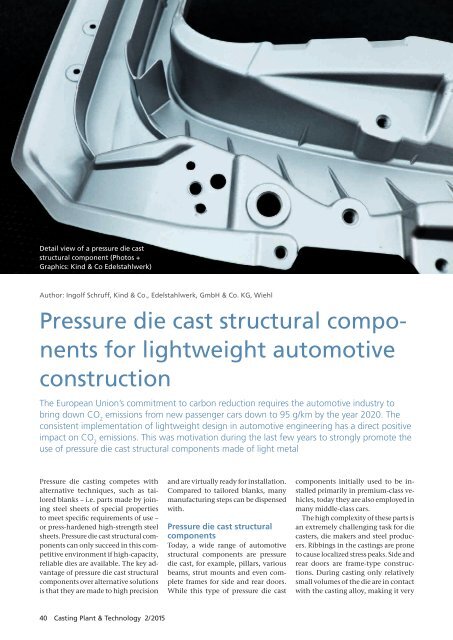CPT International 02/2015
The leading technical journal for the global foundry industry – Das führende Fachmagazin für die weltweite Gießerei-Industrie
The leading technical journal for the
global foundry industry – Das führende Fachmagazin für die
weltweite Gießerei-Industrie
You also want an ePaper? Increase the reach of your titles
YUMPU automatically turns print PDFs into web optimized ePapers that Google loves.
Detail view of a pressure die cast<br />
structural component (Photos +<br />
Graphics: Kind & Co Edelstahlwerk)<br />
Author: Ingolf Schruff, Kind & Co., Edelstahlwerk, GmbH & Co. KG, Wiehl<br />
Pressure die cast structural components<br />
for lightweight automotive<br />
construction<br />
The European Union’s commitment to carbon reduction requires the automotive industry to<br />
bring down CO 2<br />
emissions from new passenger cars down to 95 g/km by the year 2<strong>02</strong>0. The<br />
consistent implementation of lightweight design in automotive engineering has a direct positive<br />
impact on CO 2<br />
emissions. This was motivation during the last few years to strongly promote the<br />
use of pressure die cast structural components made of light metal<br />
Pressure die casting competes with<br />
alternative techniques, such as tailored<br />
blanks – i.e. parts made by joining<br />
steel sheets of special properties<br />
to meet specific requirements of use –<br />
or press-hardened high-strength steel<br />
sheets. Pressure die cast structural components<br />
can only succeed in this competitive<br />
environment if high-capacity,<br />
reliable dies are available. The key advantage<br />
of pressure die cast structural<br />
components over alternative solutions<br />
is that they are made to high precision<br />
and are virtually ready for installation.<br />
Compared to tailored blanks, many<br />
manufacturing steps can be dispensed<br />
with.<br />
Pressure die cast structural<br />
components<br />
Today, a wide range of automotive<br />
structural components are pressure<br />
die cast, for example, pillars, various<br />
beams, strut mounts and even complete<br />
frames for side and rear doors.<br />
While this type of pressure die cast<br />
components initially used to be installed<br />
primarily in premium-class vehicles,<br />
today they are also employed in<br />
many middle-class cars.<br />
The high complexity of these parts is<br />
an extremely challenging task for die<br />
casters, die makers and steel producers.<br />
Ribbings in the castings are prone<br />
to cause localized stress peaks. Side and<br />
rear doors are frame-type constructions.<br />
During casting only relatively<br />
small volumes of the die are in contact<br />
with the casting alloy, making it very<br />
40 Casting Plant & Technology 2/<strong>2015</strong>


















